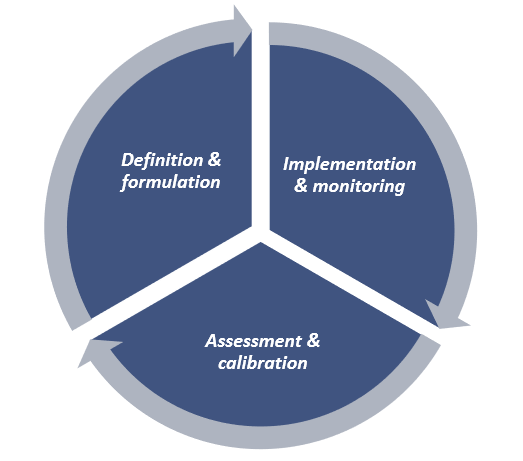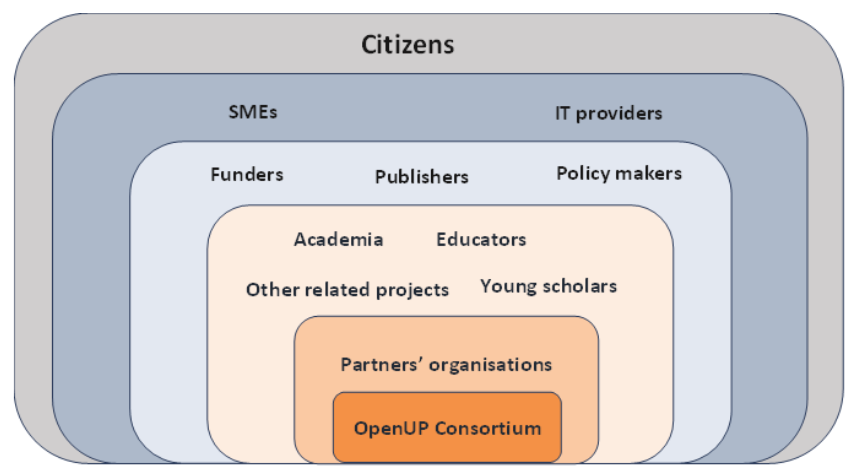OpenUP Dissemination Strategy
Short Description
The OpenUP dissemination strategy as formulated in deliverable D2.1 is a practical example of how dissemination can be implemented in an EU project.
Full Citation
Boile, M., Sifacaki, E., Toli, E. (2016). Deliverable D2.1 - Dissemination Plan. OpenUP: OPENing UP new methods, indicators and tools for peer review, impact measurement and dissemination of research. http://openup-h2020.eu/wp-content/uploads/2017/01/OepnUP_D2.1_M4.pdf
Summary
The OpenUP dissemination strategy as formulated in deliverable D2.1 is a practical example of how dissemination can be implemented in an EU project. It first formulates of objectives and goals for dissemination of OpenUP results:
Objective 1 – Raising awareness on the issues of review-dissemination-impact and highlight the benefits and importance of open science.
Objective 2 – Increasing interactions and delivering support for better coordination among key stakeholders.
Objective 3 – Creating opportunities for collaboration between ongoing initiatives.
Objective 4 – Creating a strong and recognizable OpenUP brand, identity and key messages to be used on all dissemination material.
Objective 5 – Generating positive media coverage for the project at a local, national, European and global level.
Objective 6 – Supporting sustainability and visibility of the research results even after the project's lifetime.
Then, the deliverable describes how to plan and implement dissemination activities. For each activity, the main questions need to be answered during this process: “what, who, how, when”:
I. Objectives: what are the main objectives of the dissemination activities?
II. Audience: who are the target groups for dissemination activities?
III. Tools: how will the dissemination strategy be implemented?
IV. Time: when should dissemination start and take place?
The deliverable then introduces the dissemination lifecycle, which includes 3 phases. The questions formulated above are being answered in the first phase (Definition & formulation) and dissemination activities being planned. In the second phase (Implementation & monitoring), the activities are implemented and appropriate activity measures are being monitored. In the third phase (Assessment & calibration), the methods and activities are being evaluated and corrective changes are being identified for the next iteration.
Figure 1: Dissemination lifecycle phases in the OpenUP project

Source: OpenUP D2.1 (http://openup-h2020.eu/wp-content/uploads/2017/01/OepnUP_D2.1_M4.pdf)
As for the audiences, OpenUP has opted for an onion model, which consists of 3 levels, in which the strategy is implemented progressively. The three levels are formulated as follows: within OpenUP consortium, within partners’ organisations and networks (including institutions with several institutes, departments, offices, and teams), and towards the broader community (key stakeholders, networks, related projects, etc.). (Figure 2) This graphical layering is based on the differentiation among OpenUP’s target groups, their requirements and it represents how easily they can be reached. The first two levels are the immediate environment of the OpenUP partners (i.e. the consortium and their organisations), and the third level describes the target communities.
Figure 2: Levels of dissemination in the OpenUP project

Source: OpenUP D2.1 (http://openup-h2020.eu/wp-content/uploads/2017/01/OepnUP_D2.1_M4.pdf)
For each level, aims, methods and activities are defined. In level 3, needs in terms of support and partners are mapped to each of the stakeholder groups identified. Based on this, concrete dissemination tools and activities with concrete responsibilities are defined. Finally, a range of indicators and KPIs for monitoring and assessment are provided, and the expected impact is presented.
As a concrete example, we consider young researchers, an important target audience of OpenUP project, included in the third level of the aforementioned layering. This group refers to researchers who just started their academic career and need consultancy and advice on publishing and increasing the impact of their scientific work. One of the selected communication methods that OpenUP will use to reach this audience is social media. OpenUP will disseminate its recommendations by posting targeted messages on social media. The writing style of posts will be direct and relatively casual in contrast to the formal style used when reaching out other target groups, like policy makers. Additionally, the OpenUP team will monitor the progress and effectiveness of this activity with social media metrics such as the number of followers, shares and likes.
Access
Gold
Link
http://openup-h2020.eu/wp-content/uploads/2017/01/OepnUP_D2.1_M4.pdf




